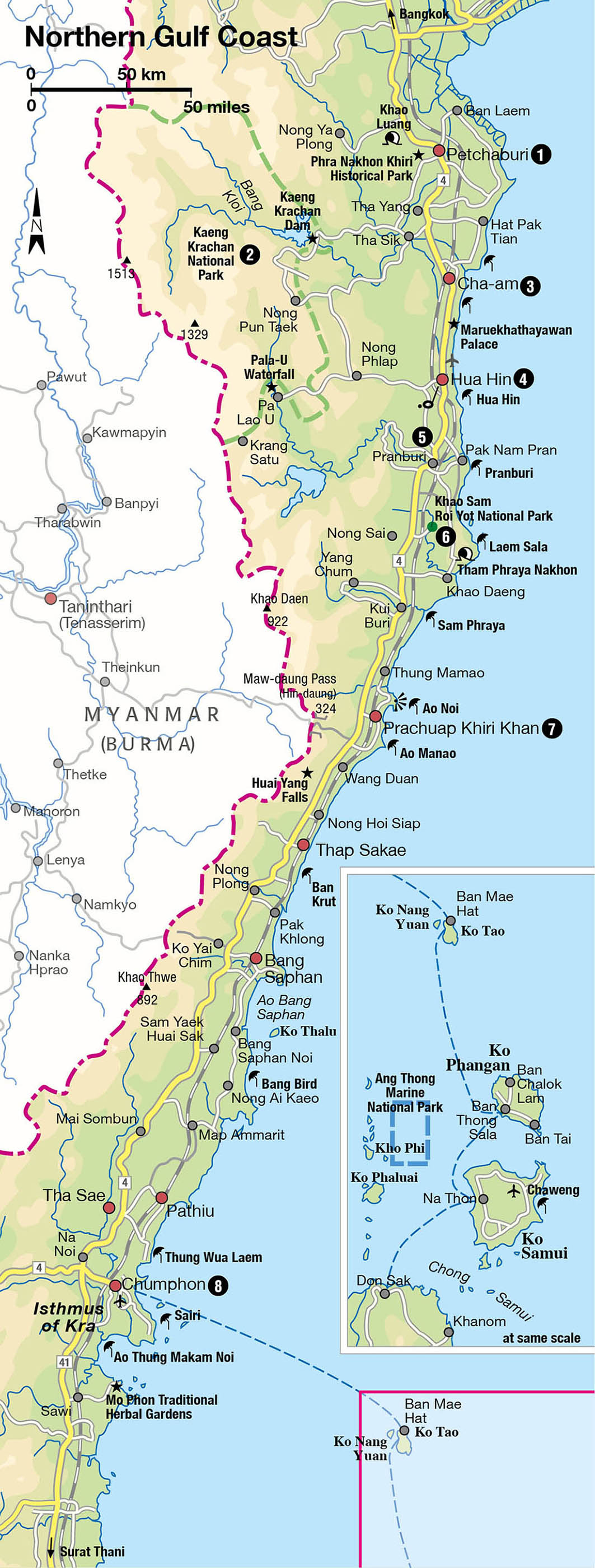Wedged between the Gulf of Thailand and the Andaman Sea, southern Thailand geographically resembles an elephant’s trunk snaking down narrowly from below the Central Plains to the tip of the Malay Peninsula. The Isthmus of Kra is the name for this land bridge connecting mainland Asia with the Malay Peninsula, which, at its narrowest point in Chumphon, is only 44km (27 miles) wide from coast to coast.
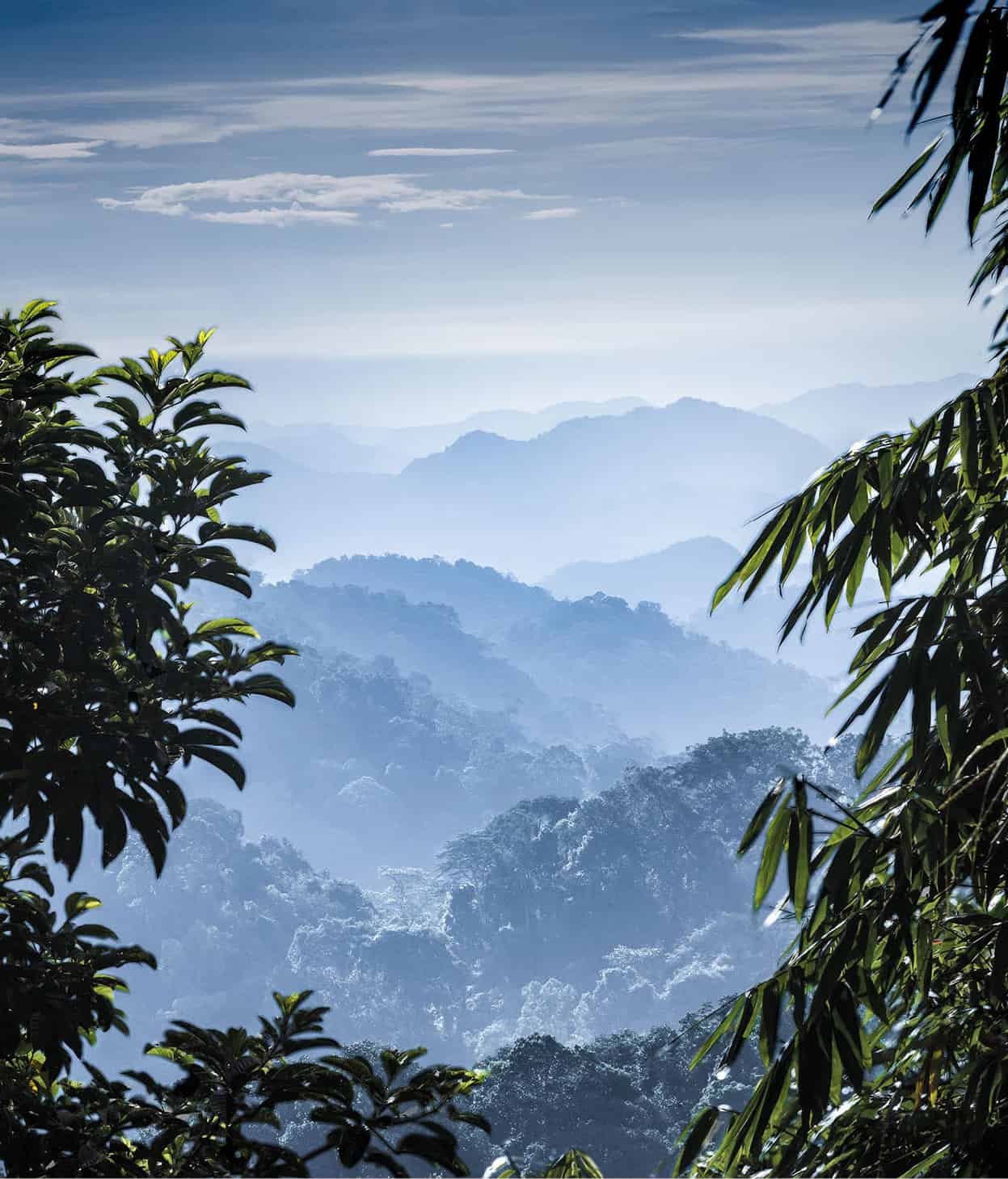
Kaeng Krachan National park at dusk.
Alamy
The 600km (373 miles) or so from Bangkok to Surat Thani province is blessed with seemingly endless sandy beaches and equable weather, plus lushly forested interiors and historic towns that harbour plenty of attractions that are well worth exploring. The southern railway line and Highway 4, which is also known as Petchkasem Highway, are the two principal links to the south, although there are also airports in Surat Thani and Hua Hin.
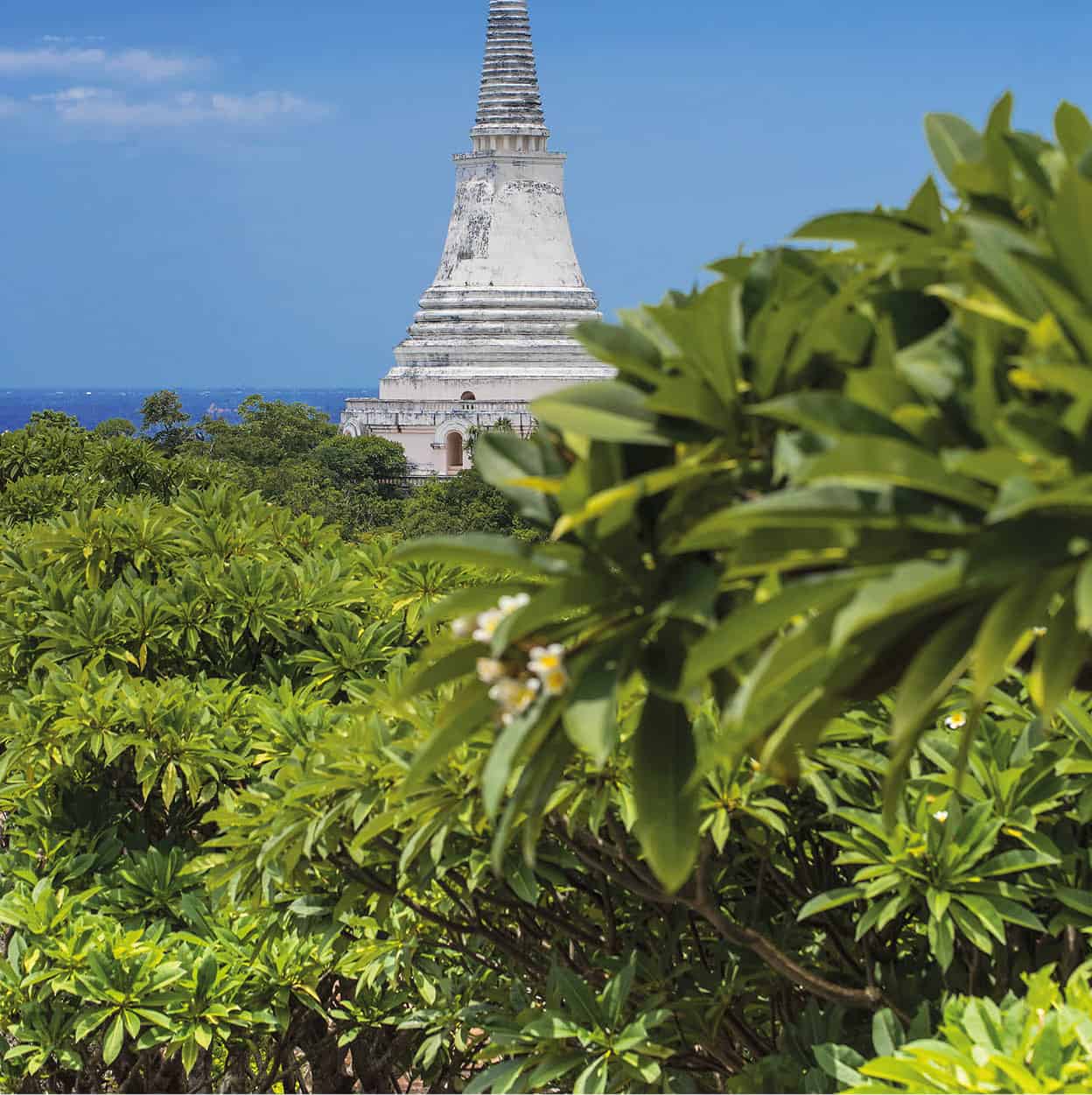
The view from Phra Nakhon Khiri Historical Park.
Shutterstock
The upper section of the Gulf coast is home to two of the country’s best-known national parks: Kaeng Krachan, also the country’s largest, and Khao Sam Roi Yot. The town of Petchaburi, with its ancient temples, is a worthy stop before travellers continue to the beach-side enclaves of Cha-am and Hua Hin, popular with Bangkokians as weekend getaways from the bustle of the city. Further south, Pranburi is growing in reputation as a high-end boutique-resort hideaway. Prachuap Khiri Khan and Chumphon see few foreign tourists, except those departing from Chumphon’s port for the boat ride to Ko Tao (for more information, click here), although the island is in fact more easily accessed from Ko Samui.
Petchaburi
Historically rich Petchaburi 1 [map] is one of Thailand’s oldest towns and has been an important trade and cultural centre since the 11th century. Lying on the Petchaburi River some 120km (75 miles) south of Bangkok, the town has come under the influence of the Mon, Khmers and Thais at various times, and has over 30 temples that reflect the differing cultures and architectural styles of its various past invaders.
A pleasant place to while away a day or two, Petchaburi is easily navigable on foot. It has a laid-back provincial atmosphere with little in the way of modern conveniences.
Khao Wang
Just west of town, and providing a useful geographical reference, is the 92-metre (302ft) hill called Khao Wang (Mount Palace). Commissioned in 1860 as the summer residence of King Mongkut (Rama IV), the entire complex is now known as Phra Nakhon Historical Park (daily 8.30am–4.30pm; tel: 0-3240 1006; charge). It is a curious melange of Thai, Chinese and Western architectural styles taking the form of shrines, temples, pagodas and other structures. Many of these offer fabulous panoramas of the vicinity, especially around sunset.
The hilltop buildings include three throne halls (two of which have been turned into a museum housing an assortment of furniture and collectibles belonging to King Mongkut); a neoclassical observatory (the king was an avid astronomer); a large white chedi; and Wat Maha Samanaram. The steep cobblestone trail to the peak winds through forest and well-kept gardens populated by inquisitive monkeys. The easier option is to take the rickety cable car (daily 8am–5pm) on the Petchkasem side of the hill; its entrance is marked by a line of souvenir shops.
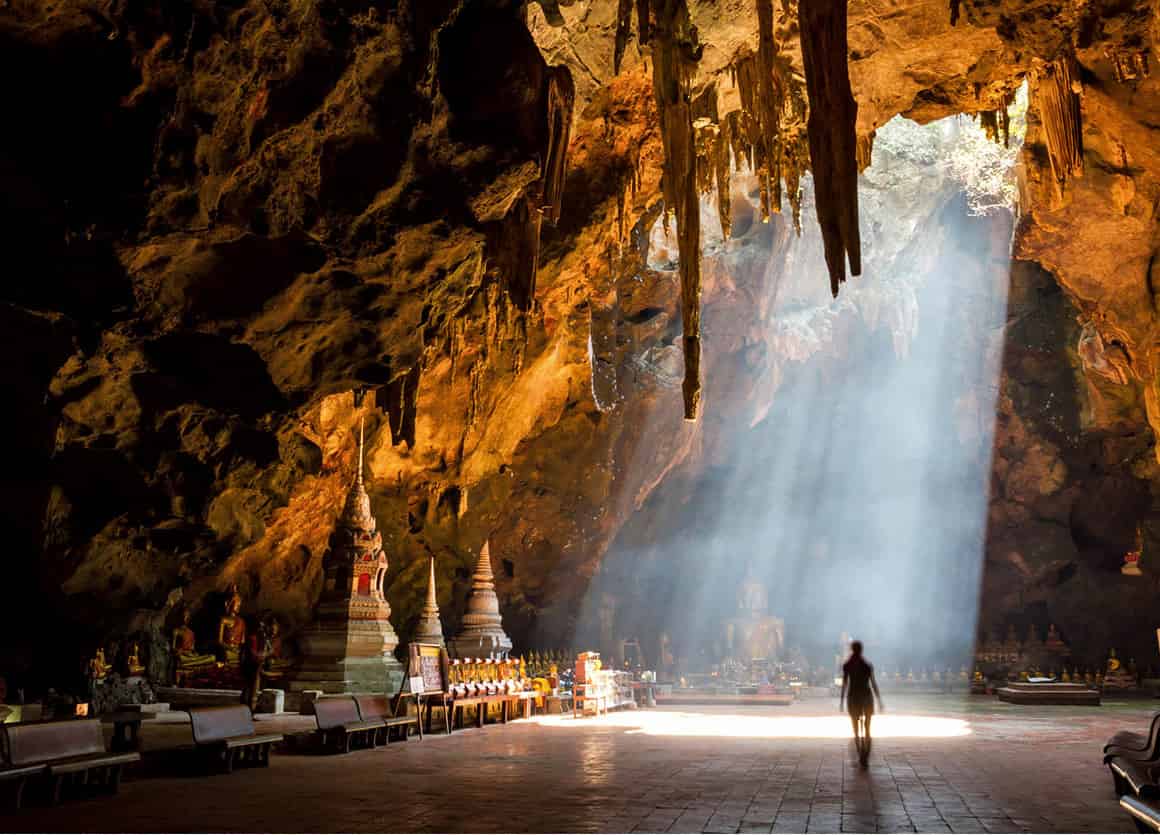
Khao Luang cave.
Bigstock
Other key temples
Some of Petchaburi’s more important religious sites include the five laterite Khmer prang of the originally Hindu Wat Kamphaeng Laeng (daily 6am–5pm; free), which possibly marks the southernmost point of the Khmer kingdom. Located on Thanon Phra Song, the temple dates from the 12th century. Although the towers have undergone some restoration work, they are still dishevelled enough to look authentic.
Just around the corner from here, on Thanon Phongsuriya, is the 17th-century Wat Yai Suwannaram (daily 6am–5pm; free). The temple is best known for its fading murals of Hindu gods that date back to the 18th century. Its large grounds hold a lovely teak pavilion, as well as a catfish-filled pond. Jutting out into the pond is a small stilted ho trai, or scripture library.
Back across the river and along Thanon Damneon Kasem are the five white stucco-covered prang of the town’s most dominant temple, Wat Mahathat (daily 8am–4.30pm; free). As with any Mahathat (Great Relic) temple, the 14th-century site contains enshrined relics of the Buddha, but is probably better known for the intricate depictions of angels and other mythical creatures in the low-relief stucco on the gables of the main temple buildings.
Khao Luang cave
An interesting excursion only 5km (3 miles) from town is Khao Luang cave (daily 8am–5pm; charge). Shafts of sunlight filter down from naturally hewn holes in the cave roof, creating a breathtaking sight. Rays illuminate some of the hundred or more Buddha images that rest in the three main chambers of the cave, contributing to the spiritual aura.
Beside the entrance to the cave is Wat Bunthawi, a temple with wonderfully carved wooden door panels. The hilly approach to the cave is occupied by a large group of monkeys seeking handouts from visitors (avoid feeding them, however). Unofficial guides wait near the approach to the cave, offering to turn on the cave lights for a fee.
Ban Puen Palace
As the railway line south brought greater access to this part of Thailand, a number of palaces were erected for the royal family in times past. Situated beside the Petchaburi River, along Thanon Ratchadamneon, is the Ban Puen Palace (Mon–Fri 8.30am–4pm, Sat—Sun until 4.30pm; charge; tel: 0- 3242 8506). The structure would look more at home in Germany’s Black Forest than here in the coastal flats of Petchaburi. Built in 1910 for King Rama V (the year he died), this stately Germanic home was modelled on the summer palace of Keiser Wilhelm, and designed by a German architect. The grandiose two-storey palace was intended as a rainy-season hideaway for the king. Although little in the way of furniture remains to convey its original splendour, the porcelain-tiled dining room and inner courtyard, with its pond and fountain, are interesting enough to explore, as are the expansive gardens beside the river.
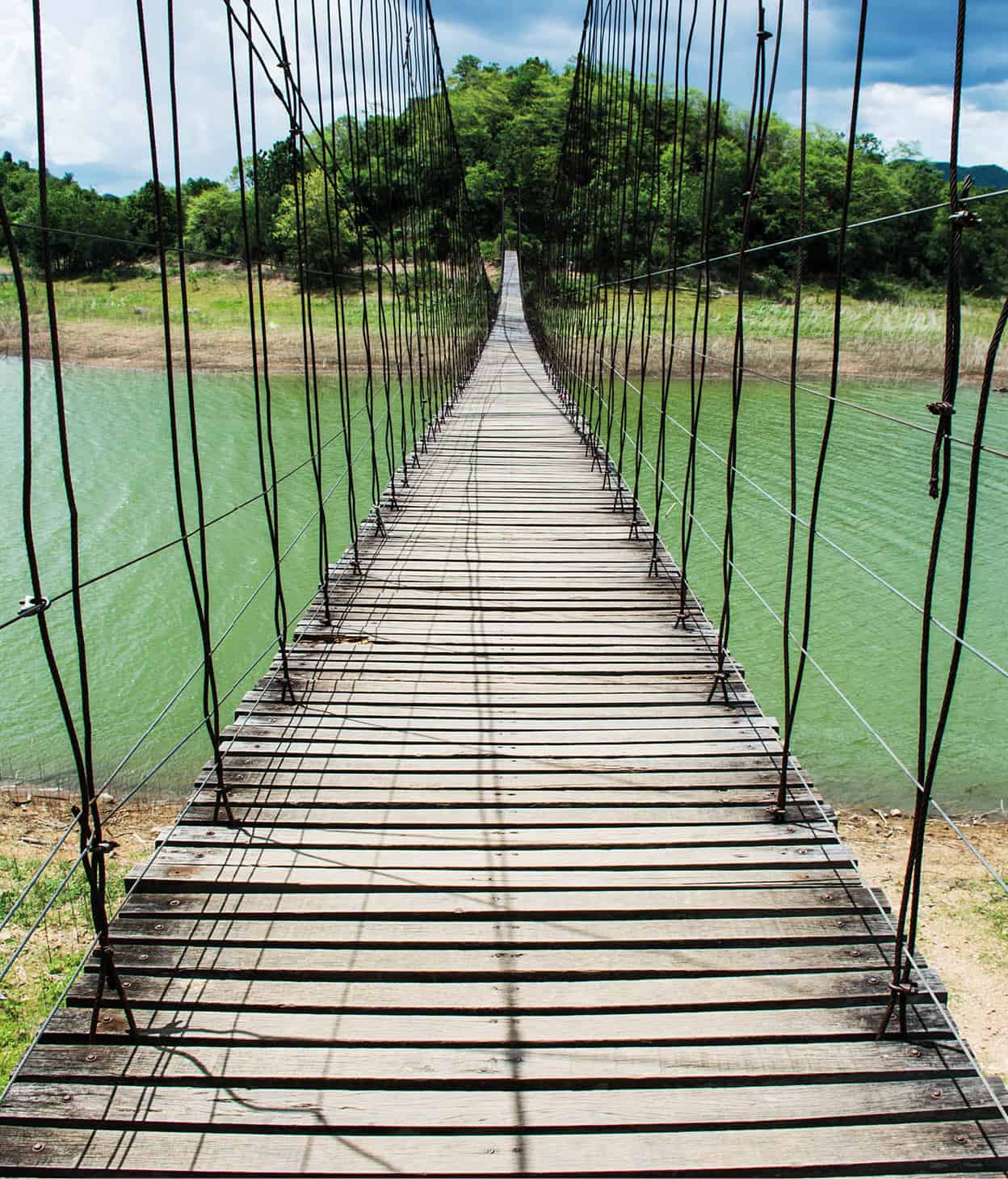
Suspension bridge spanning the river at Kaeng Krachan National Park.
Shutterstock
Located some 60km (37 miles) southwest of Petchaburi town is the vast 3,000-sq-km (1,158-sq-mile) Kaeng Krachan National Park 2 [map] (daily 5am–5pm; charge). The park – the largest in Thailand – is the source of the Petchaburi and Pranburi rivers and covers almost half of Petchaburi Province. It is a haven for numerous species of large mammal, including tigers, elephants, leopards, bears, deer, gibbons and monkeys. With around 420 species of resident and migratory birds, the park is also a prime birdwatching spot. The topography varies between rainforest and savannah grasslands, and features both a freshwater lake and rugged mountain ranges. It is possible to ascend the park’s tallest peak, the 1,207-metre (3,960ft) Phanoen Tung, for superb views of the lush countryside, or trek to the 18-tier Tho Thip Waterfall. Swimming in and boating on the vast reservoir created by the Kaeng Krachan Dam are other activities popular with visitors.
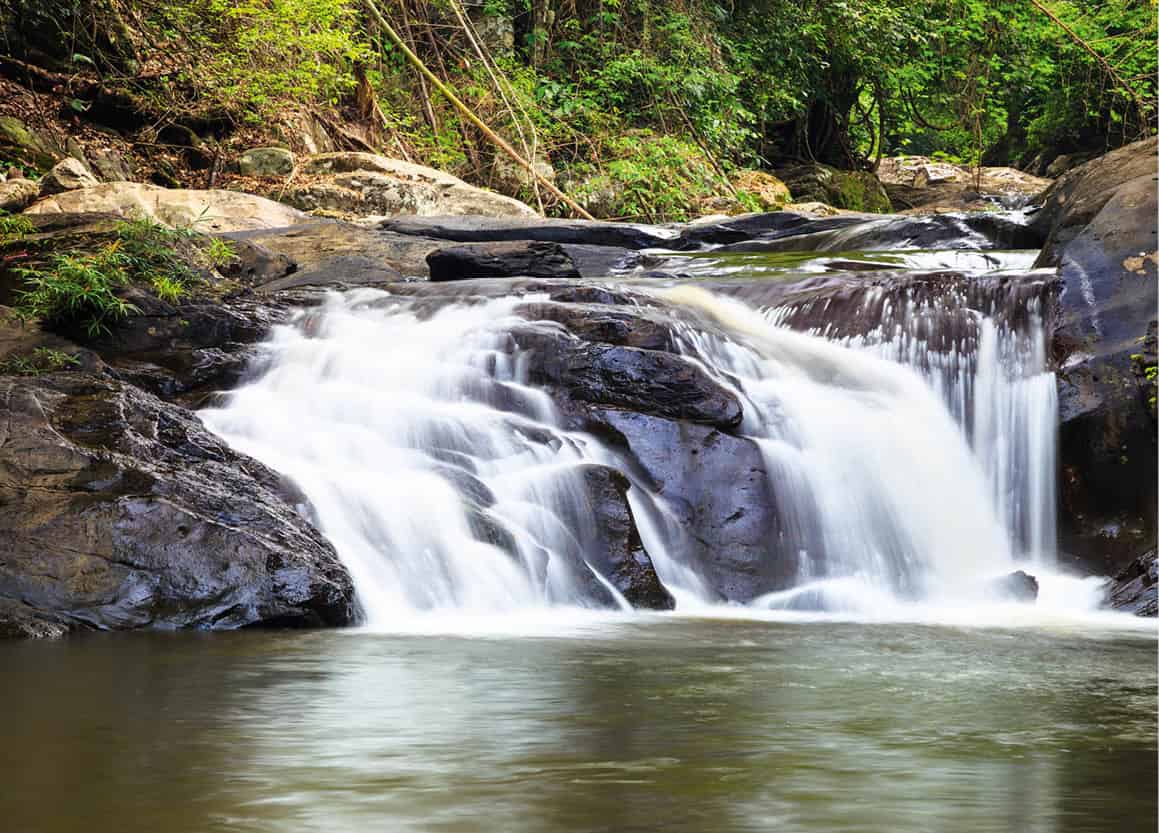
Pala-U Waterfall, Kaeng Krachen.
Fotolia
Considering Kaeng Krachan’s close proximity to Bangkok, surprisingly few tourists venture here. Trekking is the park’s main activity; guides can be hired at the park’s headquarters at the end of the road beyond the dam. On the southern edge of Kaeng Krachan, towards the mountain range that divides Thailand from Burma, is the area’s spectacular Pala-U Waterfall. Best seen during the rainy season, the fall has 11-tiers and is surrounded by dense forest. Accommodation consists of basic park lodgings, but the easiest way to visit the park is on a tour organised by hotels in Hua Hin.
Tours to Kaeng Krachan National Park often include a stop at the Wildlife Rescue Centre in Kao Look Chang, where you can visit animals that have been abused in captivity and hear about the centre’s uphill battle to save local wildlife (full- and half-day tours by appointment only; tel: 0-3245 8135; www.wfft.org). Around 24km (15 miles) from Petchaburi, the centre cares and rehabilitates more than 30 rescued gibbons, as well as bears, macaques and langurs.
Cha-am
Popular as a weekend getaway with Bangkokians is the long stretch of sand at Cha-am 3 [map]. Around 40km (25 miles) south of Petchaburi (or some 178km/111 miles from Bangkok), the beach has a different vibe from Hua Hin further down the coast, and is fairly quiet on weekdays, with plenty of seafood stalls and cheap restaurants along the beach-front Thanon Ruamchit to choose from. At weekends, however, the mood becomes more raucous as families and college students arrive in droves, picnicking (and boozing) under the casuarina trees and beach brollies, floating on rubber inner-tubes and riding on inflatable banana boats. The sand underfoot is a bit rough and the waters are less than pristine, but Cha-am does offer good value for money when it comes to hotels and food. In recent years chic minimalist hotels like the Veranda and Alila Cha-am have varied the accommodation options.
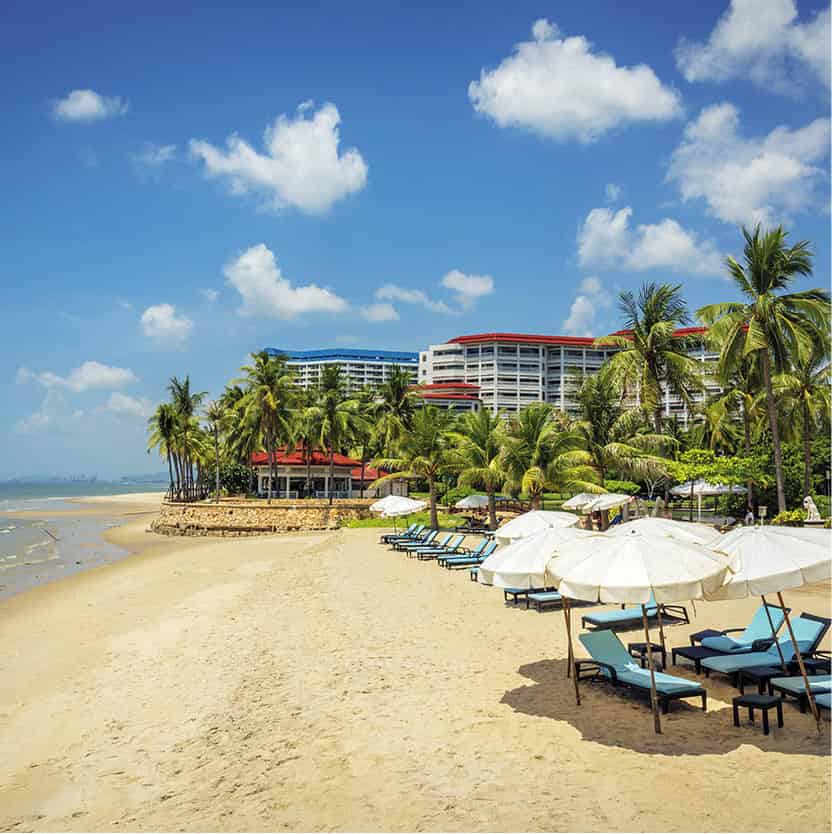
Fun on the sand at Cha-am beach.
Shutterstock
Maruekhathayawan Palace
Some 10km (6 miles) south of Cha-am, heading towards Hua Hin, is the seaside Maruekhathayawan Palace (Thu–Tue 8am–4pm; tel: 0- 3247 1005; charge). Built in 1923 from golden teak, the airy stilted structures were designed by an Italian architect and are European in style – supposedly based on sketches made by King Vajiravudh (Rama VI). Beautifully renovated in summery pastel shades, the three palace wings are interconnected by long raised and covered walkways.
The palace served as a retreat for King Vajiravudh during the two years before his death in 1925. After the king’s death, the palace lay abandoned for decades before being restored and opened to the public. The magnificent audience chamber is the centrepiece of the palace structure, with many of the smaller fretwork-topped rooms decked out in period furnishings. Despite its proximity to Hua Hin, the lovely palace grounds see few foreign visitors and only get busy at weekends with local visitors.
Hua Hin
Prachuap Khiri Khan is Thailand’s narrowest province and its coast is fringed with mountains and lovely quiet beaches, the most popular of which is the 5km (3-mile)-long sandy beach at Hua Hin 4 [map]. Located 203km (126 miles) from Bangkok, it’s as little as two hours away by road and four hours by rail. Hua Hin has long had an air of exclusivity, thanks to the private residences maintained by Thai royalty and Bangkok’s wealthy elite, and partly because of this, it retains more of a Thai family ambience than other beach destinations. Although it also has excesses if you look for them.
Tip
The Gulf of Thailand coast covered in this chapter has weather similar to that of the rest of Thailand (for more information, click here) but although the rains here continue well into Nov, the effects of the monsoon are milder. The best months of the year are from Dec to Mar, while Apr and May are the hottest months. The rainy months stretch from July to Nov.
The royal connection can be seen at the seafront teak summer residency called Klai Kangwon Palace, which means ‘Far from Worries’. Built in 1926 for King Rama VII, the Spanish-style villa is still regularly used by the royal family and is not open to the public.
One of the country’s first rail lines linked Bangkok to Hua Hin at the start of the 20th century, transporting the capital’s wealthy to the southern shores. Hua Hin thus had the aura of a European spa town, with the royals coming here for the clean air. Today, the coastal town is beginning to reclaim that mantle as several exclusive spa retreats – like the award-winning Chiva Som – cater to the needs of moneyed travellers. A string of large brand-name resorts, such as Hilton, Hyatt and Marriott, have also opened in recent years, along with local (and equally expensive) concerns such as the Dusit and Anantara.
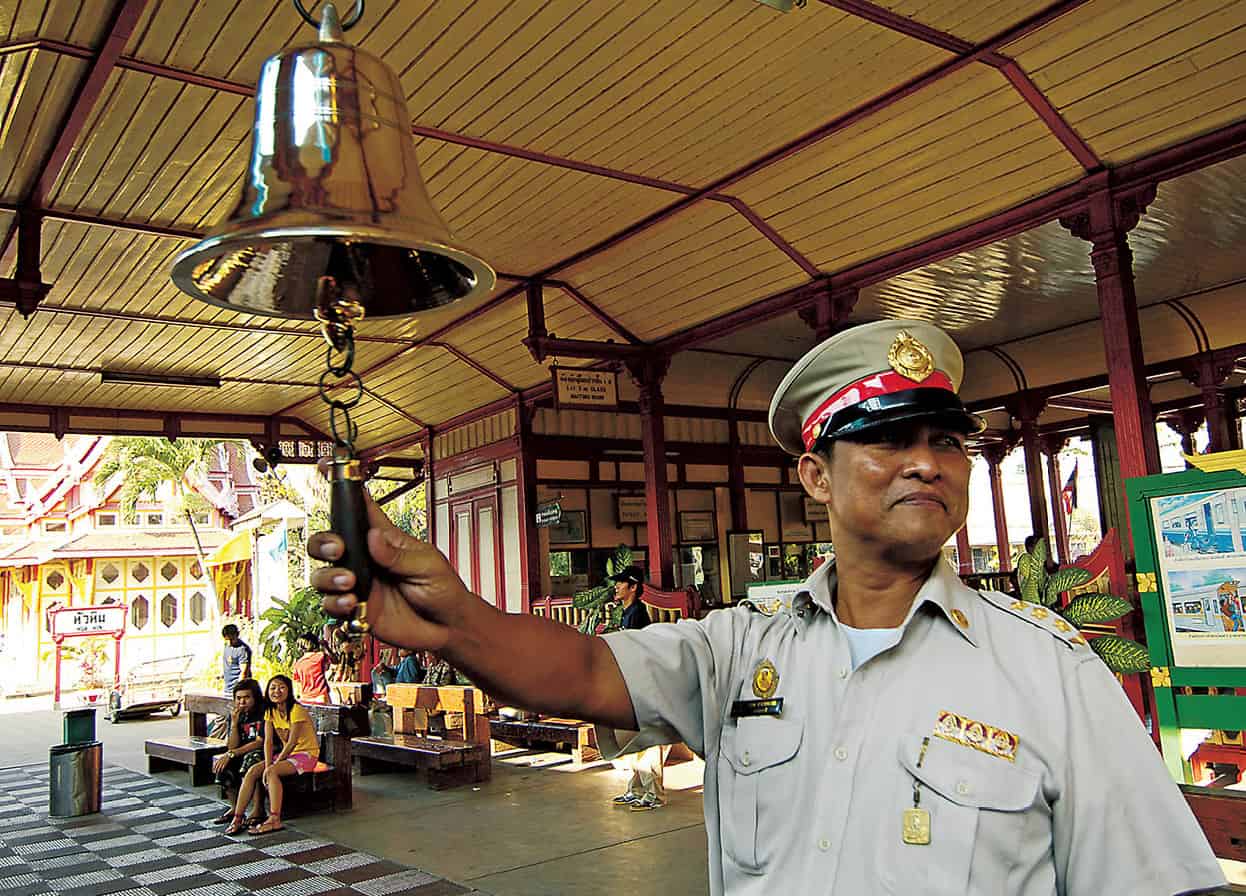
Aspects of the Hua Hin Railway Station.
John W. Ishii/Apa Publications
Hua Hin sights
Today, some visitors still choose to take the train to Hua Hin, arriving at the charming Hua Hin Railway Station. Built in the early 1920s, the station evokes the romance of a bygone era, with the cream-and-red decorated royal waiting room, once used by King Rama VI and his entourage, still intact.
Thanon Damneon Kasem leads from the railway station directly to the beach and another historic landmark, the colonial-style former Railway Hotel. Constructed in 1922, the Victorian-inspired building was the country’s first resort hotel and has now been restored to its original wood-panelled glory as the Centara Grand Beach Resort & Villas. Even if you don’t stay here, take afternoon tea or dine at one of its restaurants and then stroll through its large manicured gardens filled with topiary creatures, including a huge elephant that you can walk through.
Beside the hotel, Thanon Dam-nern Kasem ends at an alley that is the main access point to Hua Hin beach. The walkway is lined with stalls proffering tourist tat, and on the beach are boys with ponies for hire for trots along the beach.
Today, the wide and sweeping run of Hua Hin beach is backed by the summer homes of Bangkok’s elite, along with a slew of faceless condo developments. Some of the beachfront homes, which fuse elements of Thai and Western architecture, date back almost a century and are owned by influential families.
A few of these historic abodes have been restored and converted into unique boutique resorts, like Baan Bayan and Baan Talay Dao, while Baan Itsara is one of Hua Hin’s better restaurants. Hua Hin is also fast gaining a reputation as a place to retire, and more and more condos and beach houses are being built to accommodate the upsurge.
The beach, punctuated by occasional boulders that give it a scenic beauty, lacks the character of Thailand’s palm-fringed island bays, but is great for long undisturbed strolls. The beaches further south of town, Suan Son and Khao Tao, are nicer and more secluded, but again, not extraordinary. While the sea is generally calm during the low season period of May to September, the winds can whip up the water towards the end and start of the year. This is when windsurfers and kite-surfers take to the water (as the sea has jellyfish, it’s advisable to wear long shorts).
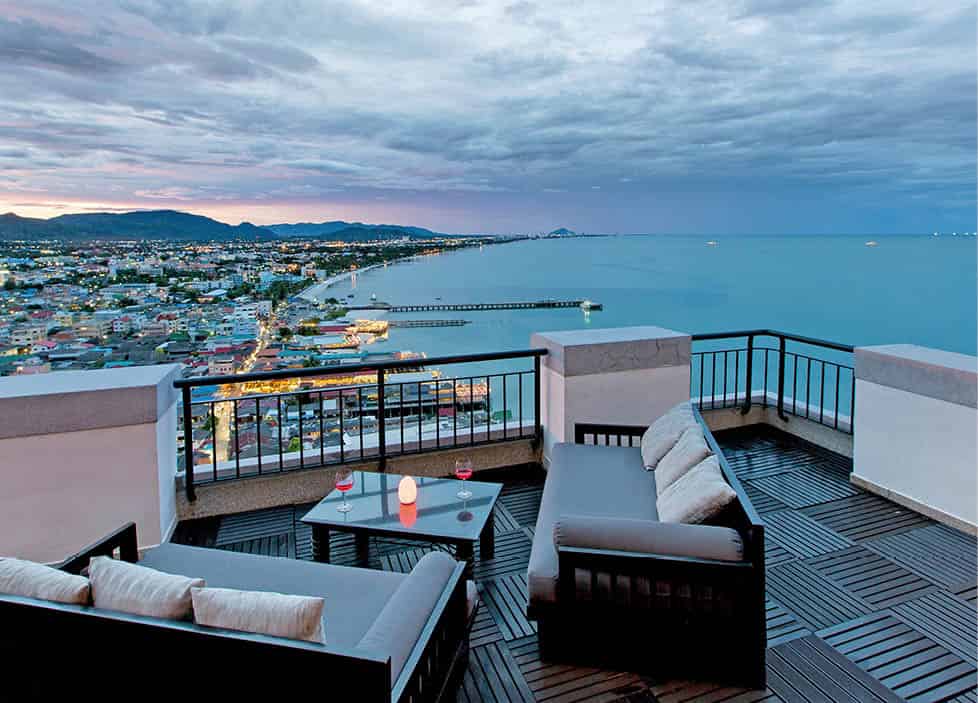
Hilton Hua Hin is one of several luxury hotels on the beach.
Hilton
Outside Hua Hin
For a bird’s-eye view of Hua Hin, head up steep Khao Hin Lek Fai hill for some of the best panoramas of the beach. Around 3km (2 miles) west of town, turn down Soi 70 and follow the signposts for the viewpoints (six different spots are marked around a recreational park) from which the scenery can be enjoyed. Dawn and sunset are the best times to stop here.
Visible a few kilometres south of town is Khao Takiab (Chopstick Hill), a rocky outcrop that marks the end of Hua Hin beach. It is a steep climb to the top but the views of the surrounding coast are worth the sweat. The hill is split into two windswept peaks, the nearest festooned with several small shrines and with a steep staircase that leads down to a towering 20-metre (66ft)-tall Buddha image. Dramatically standing just above the crashing surf, the image looks back toward Hua Hin beach with hands outstretched.
On the other brow is Wat Khao Lad, with its lofty pagoda atop a tall flight of stairs. A little further round the headland is a garish Chinese shrine with a large statue of the Goddess of Mercy, Kwan Im. A road splitting the two peaks leads to one of Hua Hin’s most popular seafood restaurants La Mer.
Activities
These days, as tourism, with all its associated trappings, increases its grip, the image of the resort as a low-key family getaway is becoming a thing of the past. The town’s nightlife has picked up in the last few years as more ‘beer bars’ (but no go-go bars as yet) open, with more girls recruited to draw in customers. Despite this, Hua Hin retains its small seaside-town charm and is far removed in atmosphere from the raunchy red lights of Pattaya.
Along with this upsurge in nightlife, a number of new restaurants have appeared in the area, too. While Hua Hin was always known as a place for wonderfully fresh seafood, the diversity of culinary options has expanded beyond just Thai. These days, Japanese, Korean, Scandinavian, German, French and Italian eateries reflect the nationalities of the major tourist arrivals. The restaurants and bars are mainly clustered into a small area around Thanon Naresdamri and behind, on the parallel Thanon Phunsuk. Soi Bintabaht has the highest concentration of girly bars, and the pier area along Naresdamri serves some of the best grilled seafood in the town.
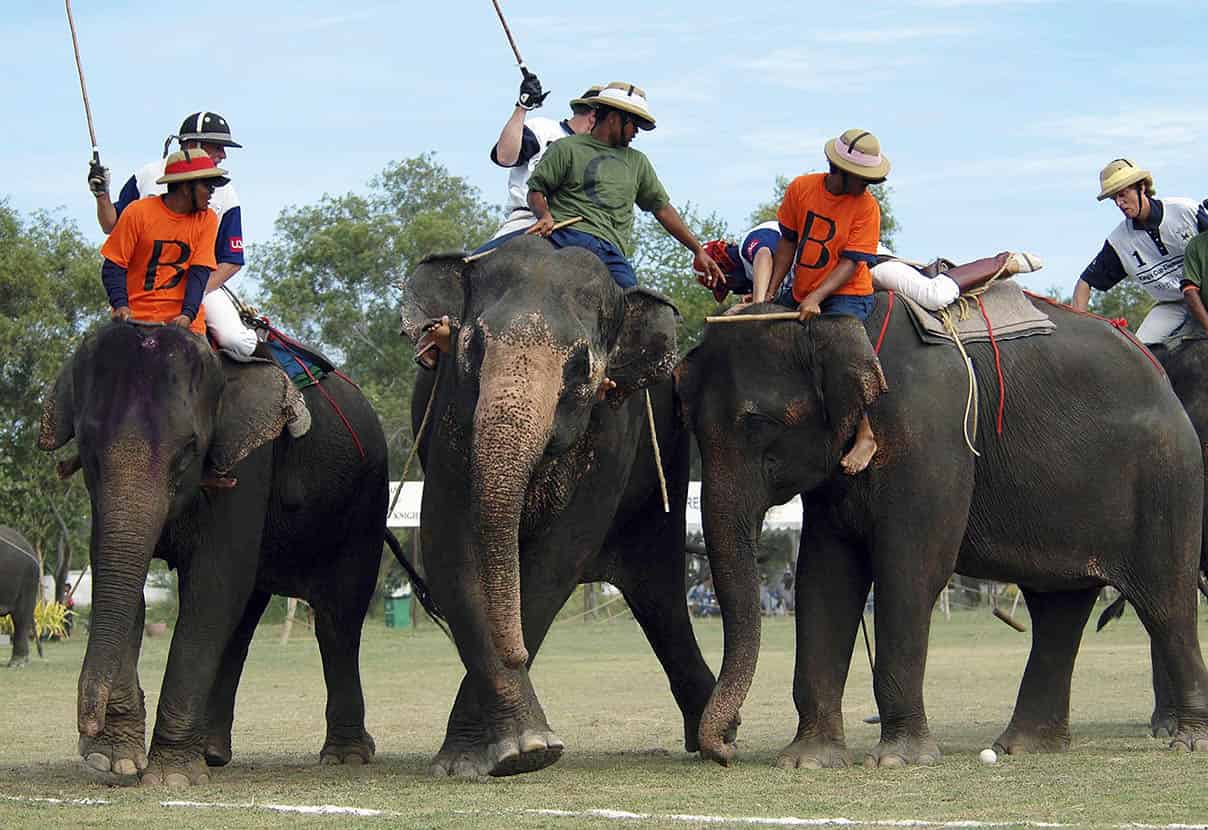
At the World Elephant Polo Championships.
Getty Images
Hua Hin hosts a lot of activities and events, usually organised at weekends to cater to the Bangkok crowds. These include the annual Hua Hin Jazz Festival (www.thehuahinjazzfestival.com), generally held in June. It mainly consists of Thai bands, many of which would struggle to justify the jazz moniker, but has included the likes of Bill Bruford’s Earthworks in the past. The Hua Hin Regatta falls in April and attracts sailors from around the region to compete in several classes. There may be crewing opportunities if you want to sail but have no boat.
In tune with the town’s historical legacy, the Hua Hin Vintage Car Parade each December or January marked its fifteenth anniversary in 2018. It sees over 50 classic cars drive from Bangkok to Hua Hin’s Centara Grand Beach Resort before taking a photo opportunity lap down the town’s streets. For the latest information and listings, pick up a copy of Hua Hin Today newspaper.
Hua Hin may not boast as many golf courses as Pattaya, but what Hua Hin lacks in numbers, it makes up for in heritage. In the 1920s, the king and members of the country’s aristocracy played their first game at the Royal Hua Hin Golf Course, the country’s first-ever golf course. Today, there are several courses within striking distance of the town, with more on the way.
Pranburi
The beaches south of Hua Hin towards Pranburi 5 [map] continue to see development. Around 20 minutes’ drive from Hua Hin, Pak Nam Pran, the mouth of the Pranburi River, marks the beginning of a clean but fairly unremarkable beach that runs down towards Sam Roi Yot National Park. Here are some of Thailand’s most exclusive beachfront hideaways, including the magnificent Evason, the north African themed Villa Maroc and the plush, celebrity-friendly Aleenta.
Most people who stay at these places may have no reason to leave the luxurious confines of their hotel, although some resorts organise tours to the mangrove-lined Pranburi River estuary and to Sam Roi Yot.
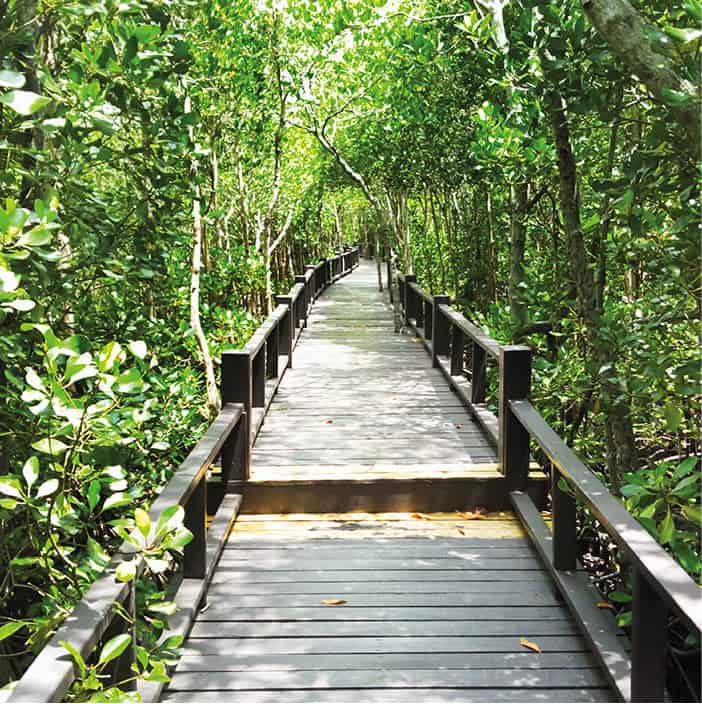
Mangrove nature trail in Pranburi National Park.
Shutterstock
Located 63km (39 miles) south of Hua Hin is Khao Sam Roi Yot National Park 6 [map], which translates as ‘Three Hundred Mountain Peaks’ and refers to the dramatic landscape of limestone pinnacles jutting up from the park’s mangrove swamps to heights above 600 metres (1,968ft). Carved from the rugged coastline, the 98-sq-km (38-sq-ft) park (daily 6am–6pm; charge) features beaches, marshes and brackish lagoons, forests, caves and offshore islands. Wildlife includes a multitude of migratory birds that congregate on the freshwater marsh and mudflats, unusual crab-eating macaques and the rare serow – a mountain goat-antelope. At certain times of the year, pods of dolphins also swim along the park’s shores.
The park’s most famous attraction, the huge cave of Tham Phraya Nakhon is reached by boat or by foot along a steep half-hour trail from Hat Laem Sala. Its large sinkhole allows shafts of light to enter and illuminate the grand Thai-style pavilion or sala called Phra Thinang Khuha Kharuhat. It was built in the 1890s for a visit by King Chulalongkorn (Rama V). Other noteworthy caves are Tham Sai and Tham Kaeo (Jewel Cave), the latter with glistening stalactite and rock formations. The park’s best viewpoint is at the 300-metre (984ft) Khao Daeng outcrop at the southern end of the park.
Most Hua Hin and Pranburi hotels organise day trips to the park, but independent travellers can catch a train or bus to Pranburi, and from there take a songthaew to the fishing village of Bang Pu, inside the park. From here, catch a short boat ride or walk across the headland from the village to the park checkpoint on Hat Laem Sala beach.
There is accommodation run by the Forestry Department here, but a better alternative is to stay at a hotel, such as the family-friendly Dolphin Bay Resort, located at Hat Phu Noi beach, a few kilometres north of the park.
Fact
In 1868, King Mongkut, an astute astronomer, visited Khao Sam Roi Yot National Park to view a total eclipse of the sun, which he had foretold. The king’s prediction, to the astonishment of local astrologers, was only four minutes off the mark. Sadly, Mongkut contracted malaria from this trip and died a week after his return to Bangkok.
South of Pranburi
The coastline south of Khao Sam Roi Yot is still miles and miles of sandy beaches, yet most foreign tourists make the jump directly to Chumphon for ferry connections to Ko Tao (for more information, click here), or to Surat Thani and then by boat to either Ko Samui (for more information, click here) or Ko Phangan (for more information, click here).
While this stretch of the Gulf of Thailand coast may not be geared towards pampering foreign visitors, you will be rewarded with the less commercial face of Thai tourism.
Prachuap Khiri Khan 7 [map], about 85km (53 miles) from Hua Hin, is an interesting town to explore, as are the beaches of Ao Manao, 4km (3 miles) south of Prachuap town, and Ban Krut, 70km (43 miles) south. Both beaches have limited facilities in the way of accommodation and restaurants. Offshore from the town of Bang Saphan Yai, further south, is Ko Thalu, one of the first islands south of Bangkok that is good enough for snorkelling and diving.
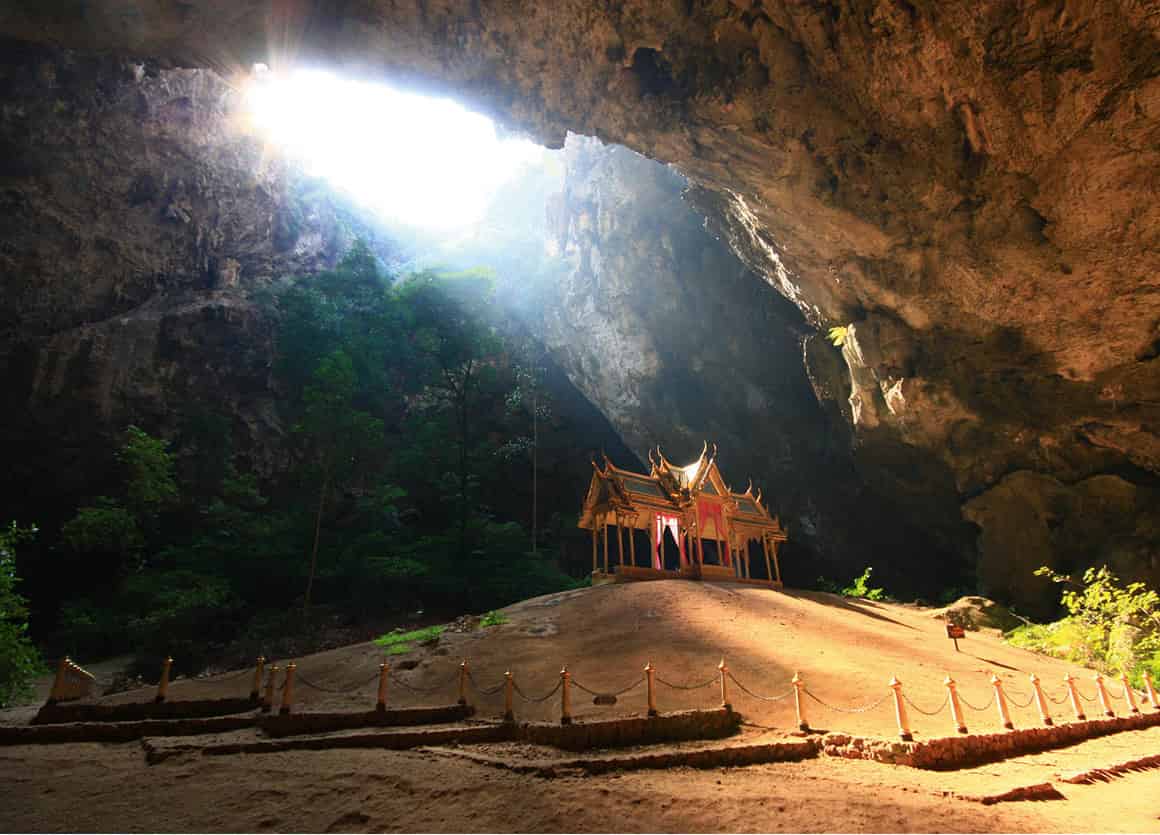
The famous sala, or pavilion, at Tham Phraya Nakhon.
Bigstock
Located 184km (114 miles) from Prachuap Khiri Khan, and considered the start of southern Thailand, is Chumphon 8 [map]. It has several good beaches, including Thung Wua Laem, 12km (7 miles) north of Chumphon town, and Ao Thung Makam Noi, about 25km (16 miles) south. Some 20km (12 miles) offshore are the reef-fringed islands of Ko Ngam Yai and Ko Ngam Noi, popular with divers, while 80km (50 miles) away is Ko Tao (for more information, click here), another diving hotspot.
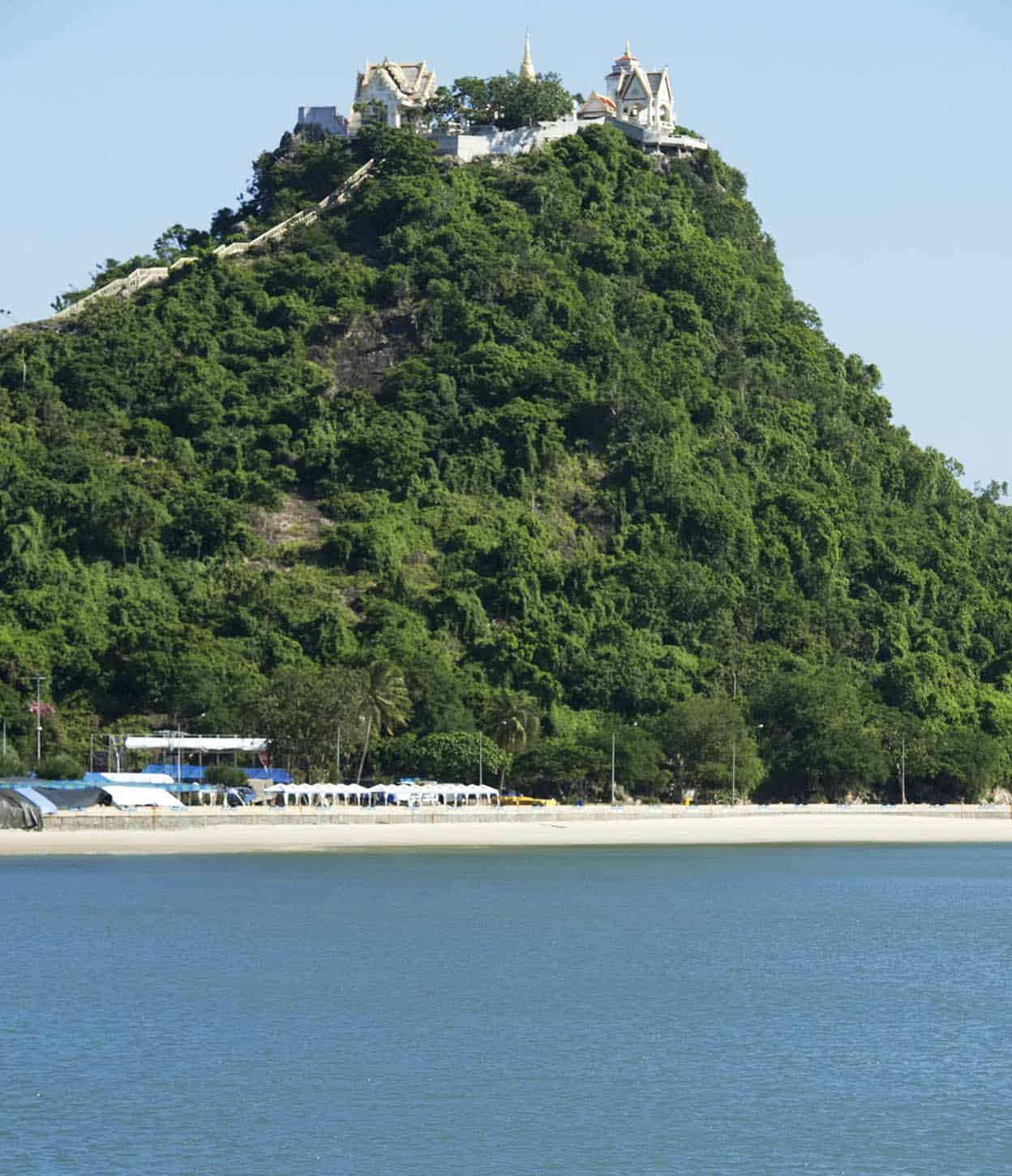
Wat Thammikaram Hill.
Design Pics Inc/REX/Shutterstock
